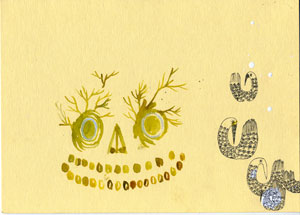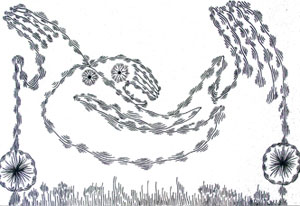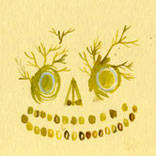Devendra Banhart‘s creative aesthetic pervades his entire existence. It blankets every note from his guitar, every warble and billowing vibrato of his voice, every mark of his pen, every inch of his beard. Banhart and his work possess a kind of strange beauty that can only be conveyed in the unique and otherworldly manner in which we find them. The eccentric free-spiritedness with which Banhart composes himself and his music is matched only by that of his impressive following of hipsters and folk-heads alike. He’s also kind of crazy—the pretty kind.

Banhart’s songwriting has always existed in a world all its own,bursting forth with its own bizarre whimsy. It’s classified only by thesubgenre he is often credited with spearheading along with JoannaNewsom: freak folk. His lyrics are romantic, redolent and nonsensical. The songsthemselves confound convention. And while his drawings, unlike hismusic, have yet to spark an entire movement in their wake, the two doshare many of the same traits.
Banhart is currently featured in a two-person show at the San Francisco Museum of Modern Art alongside none other than Paul Klee . The exhibition, titled Abstract Rhythms,explores the relationship between music and art. Banhart’s drawings inthe exhibition were made in conjunction with his new album Smokey Rolls Down Thunder Canyon,a collection of songs with dozens of influences, sung in multiplelanguages. Born in Houston but raised in Caracas, Venezuela, Banhart’sinfluences are as myriad as they are diverse, a fact apparent in bothhis songwriting and his art. Klee is hardly a modest pairing forBanhart, despite the fact that Banhart’s recent exhibitions havegenerated enough press clippings to fill a Volkswagen van. His celebrity has an unquantifiable influence on the prestige of his art, and I should be honest about the fact that I’m a Banhart fan. Let’s just get it out in the open.
It’s nearly impossible to separate Banhart’s music from his art as evidenced in Some Drawings, an exhibition of the artist’s fine-lined ink drawings at DiverseWorks Art Space . While you may have seen Banhart’s work in the form of cover art for several of his musical releases, Some Drawings,organized by Stuart Horodner, curator at the Atlanta Contemporary ArtCenter, presents a mixture of works from private collections and CANADA Gallery in New York. The artist’s second full-length release, Rejoicing in the Hands,plays in the gallery and directly relates to the drawings’ imagery.Nearly all of the fifteen drawings in the show contain characterscomposed of pairs of thin-fingered hands or semicircular hand-likeshapes. And like the album, Banhart’s drawings celebrate informalitywith a genuine frivolity–they are unique tributes to uncomplicatedpleasures.
Composed entirely of a collection of jagged, vertical lines, Spirit of Six Point Cloud Peopleis an example of Banhart’s fondness for the surreal. Two of theartist’s trademark hands rest in the place of eyes, set on a facedefined only by the shape of a beard and a pair of lips constructed bysmaller lines. As if hung from a hairy chin, long tufts collapsedownward in several layers, flanked by towering flames of the sameshape that stand upright and tall like blades of grass. In a lyric fromThis Is the Way, the opening track from Rejoicing in the Hands,Banhart sings, “This is the beard I’m always growin’ / I know they’rehere, I see them floating / Her empress beards, they float so holy /Their beards are here, they gently hold me.” It becomes difficult todetermine where the music ends and where the drawings begin. And viceversa.

Birds are often associated with a sense freedom and they play asignificant role in many of Banhart’s lyrics. His fondness for them isalso evident in two untitled works in the show. The larger one featureswhat looks like a native headdress with a slender beak that extendsdown over what might be a chin. Eyes, cheeks, shoulders, and even heavypigtails are composed solely of tiny hands and a collection ofsemicircles that could be rainbows sans color. Two arms stretching outof the mask reach up over the head like a ballerina, but with anawkward grace. Its untitled companion is a similarly beaked characterwhose form is shaped by never-ending hills of semi-circles and whosehead is crowned with two pairs of hands, right and left. They pointupward, as if in exaltation of some avian god. Banhart’s imagerycontains traces of Indian art and references to ancient spiritual narratives, yet it remains very much his own as he combines his influences with bizarre beast-like forms and a herd of whimsical lines.
The hands and half moons create texture and spatial relationships withlittle effort. Some of the drawings, done on aged cream colored paperwith frayed edges, look like they were executed on flyleaves torn froma first edition of Leaves of Grass. Meanwhile several drawings feature tiny fields of correction fluid, with lines inked over the white areas. Red Monument, drawn on bookbinding, resembles a similar drawing Banhart created for the cover of his first full-length album, Oh Me Oh My…The Way The Day Goes By The Sun Is Setting Dogs Are Dreaming Lovesongs Of The Christmas Spirit. The informal use of found papers and white-outgives the impression that many of the works in the show, especially thesmaller pieces, may have been drawn while on tour using whatever was onhand. But the casual nature of these drawings, whether intended or not,comes as no surprise in the wake of Banhart’s low-fi recordings and hisnouveau hippy aesthetic.
Whether you buy into the freak folk thing or not, whether youunderstand the drawings or not, they’re whimsical, uncomplicated andseveral different kinds of crazy, but kind of gorgeous. Like watchingan Almodóvar or Fellinifilm, you have to agree to be a part of his world before you enjoyyourself. You become very aware that you’re seeing something crafted byDevendra Banhart. Not because he’s the only man capable of imaginingsomething so strange and beautiful, but because his music and his arthave woven into each other to create a singular being. Some people maycall it limited. Record execs might call it branding. I call it a pointof view.
Evan J. Garza is a writer and Assistant Director of Deborah Colton Gallery in Houston.





3 comments
c,
fyi, the arensbergs never lived in philadelphia. they moved from new york to los angeles in the late 1920’s. their collection is in the philadelphia museum because they offered them (through duchamp, who negotiated the terms, as president of the francis bacon foundation[devoted to proving that francis bacon was the real author of most works attributed to shakespeare]) the best installation agreement. this is because during the 1930’s and 40’s most of the collections promised to the philadelphia museum went instead to the then new moma in manhattan.
Rangy, adj.
1. Having long slender limbs.
2. Inclined to rove.
3. Providing ample range; roomy.
i don’t think the fellini metaphor flies…